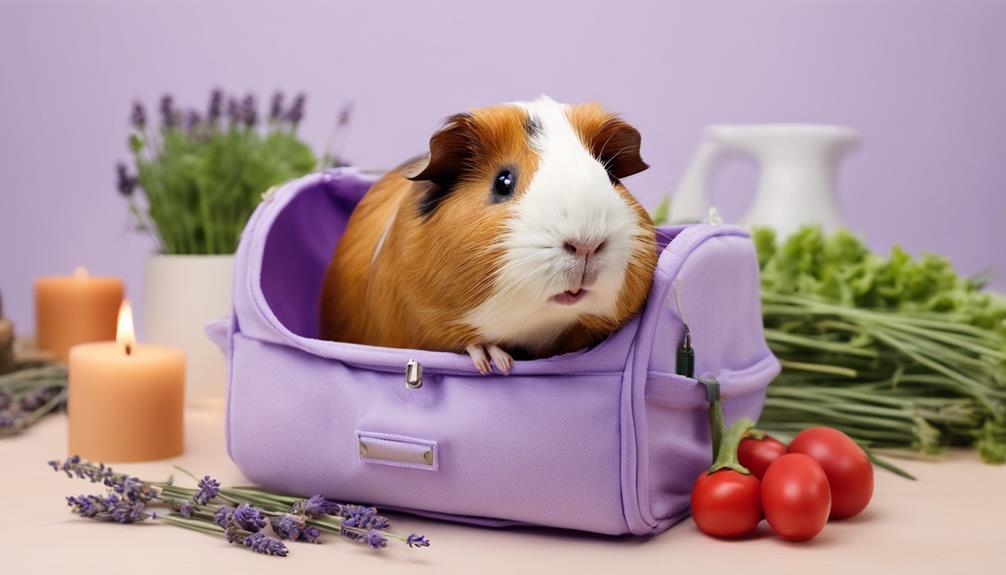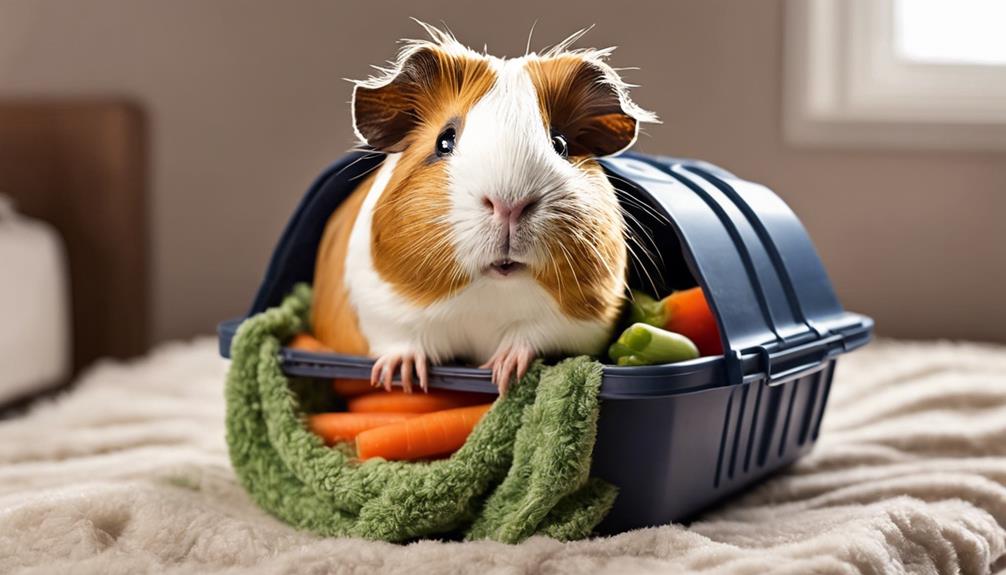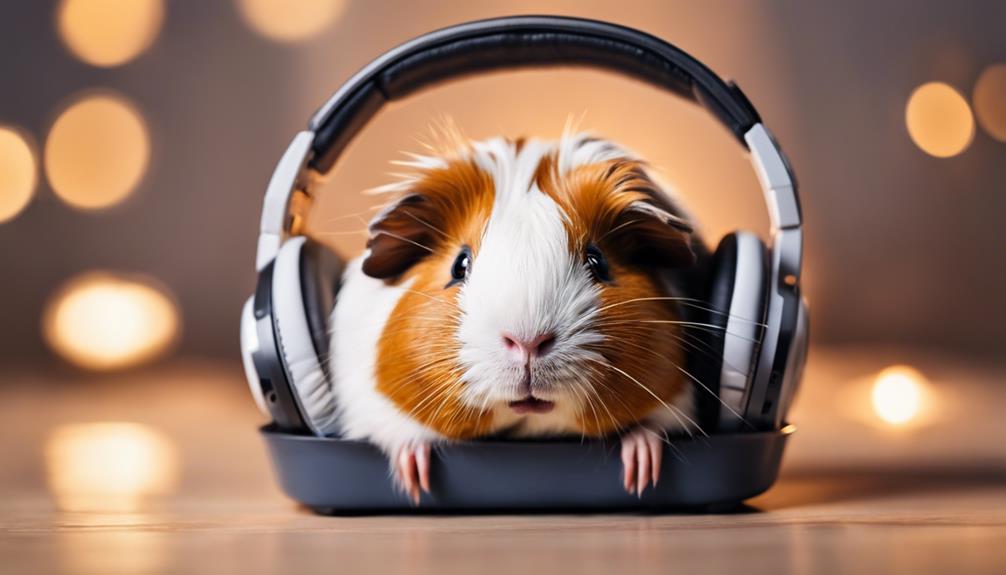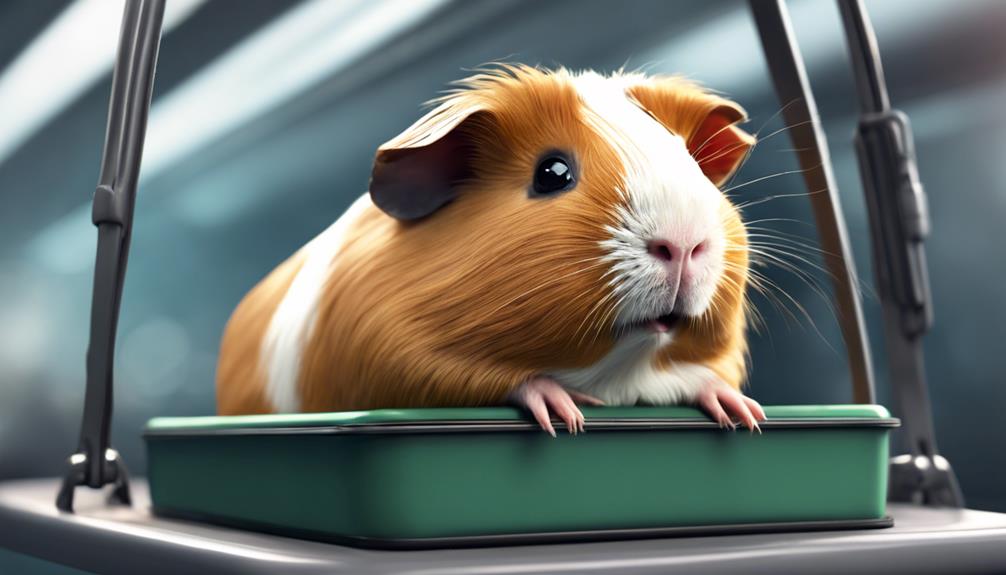What to Do to Keep Your Guinea Pig Calm in Transit

Tips for Keeping Your Guinea Pig Calm in Transit:
Create a Cozy Carrier.
Monitor Behavior.
Ensure Comfort.
Stress-Free Trip Guaranteed!
Key Takeaways
- Create a carrier environment resembling home for comfort
- Familiarize and bond with the carrier gradually
- Ensure proper care, ventilation, and comfort inside the carrier
- Monitor signs of distress and provide a safe, gentle transit experience
Prepare a Cozy Carrier
To guarantee your guinea pig stays calm during transit, prepare a cozy carrier that mimics their comfortable home environment. Stress relief techniques are essential when traveling with small pets. Include comfortable accessories like soft blankets to create a soothing space. Consider adding calming scents such as lavender or chamomile to help reduce anxiety.
The carrier should be spacious enough for your guinea pig to move around but cozy enough to make them feel secure. Avoid overcrowding the carrier with unnecessary items that could cause stress. Remember, simplicity is key when it comes to creating a peaceful environment for your furry friend.
Familiarize Them With Carrier
Introducing a guinea pig to their carrier is important for a stress-free travel experience. Start by gradually acclimating them to the carrier through short, positive interactions.
This process helps them associate the carrier with comfort and security, making journeys smoother for both pet and owner.
Carrier Introduction Process
Prepare your guinea pig for a smooth and stress-free journey by gradually introducing them to their carrier in a calm and reassuring manner. Begin by implementing relaxation techniques and bonding exercises during the carrier introduction process. This will aid in stress reduction and trust building, essential for a positive travel experience.
Create a comforting environment around the carrier, using familiar bedding and placing their favorite treats inside to encourage exploration. Spend time near the carrier, talking softly to your guinea pig to familiarize them with your presence during this new experience.
Gradual Carrier Exposure
Ease your guinea pig into the carrier environment gradually, allowing them to become familiar with their surroundings before the journey begins. A slow introduction to the carrier helps reduce stress and anxiety. Start by placing the carrier in their living space a few days before travel, allowing them to investigate it at their own pace. Encourage exploration with treats and positive reinforcement. When they show comfort being near the carrier, gently place them inside for short periods, gradually increasing the duration. Provide cozy bedding and familiar items inside the carrier to create a sense of security. Remember, gentle handling during this process is key to building a positive association with the carrier.
| Slow Introduction | Gentle Handling |
|---|---|
| Place carrier in living space | Encourage exploration with treats |
| Increase time inside carrier gradually | Use positive reinforcement |
Positive Carrier Association
Gradually familiarize your guinea pig with the carrier to establish a positive association before travel. Here are some simple yet effective training techniques to help your furry friend feel comfortable and secure in their carrier:
- Positive Reinforcement: Use treats and gentle praise to reward your guinea pig for exploring or entering the carrier voluntarily.
- Familiar Scents: Place familiar bedding or a favorite toy inside the carrier to make it feel more inviting and familiar.
- Short Practice Sessions: Start with short sessions where your guinea pig spends time in the carrier before gradually increasing the duration.
- Consistency: Be patient and consistent with the training process, offering reassurance and rewards to reinforce positive behavior.
Ensure Proper Ventilation
To guarantee the well-being of your guinea pig during transit, prioritize proper ventilation in their carrier. Ventilation is essential for maintaining a comfortable environment inside the carrier. It helps in regulating the temperature and assuring your pet feels secure throughout the journey. Here are some key points to ponder for ensuring proper ventilation:
| Ventilation Importance | Carrier Comfort | Temperature Regulation | Carrier Security |
|---|---|---|---|
| Allows fresh air to circulate | Provides a cozy space | Helps prevent overheating | Assures the pet feels safe |
| Prevents stuffiness | Offers a familiar environment | Regulates optimal temperature | Reduces stress during travel |
| Aids in air circulation | Minimizes anxiety | Helps avoid temperature extremes | Prevents escape attempts |
| Supports overall well-being | Promotes relaxation | Assures comfort | Maintains containment |
| Enhances respiratory health | Reduces agitation | Supports a calm demeanor | Prevents accidents |
Pack Familiar Bedding

To maintain your guinea pig's comfort and familiarity during transit, make sure to pack familiar bedding in their carrier. Creating a cozy and reassuring environment for your pet will help keep them calm throughout the journey. Here are four essential items to include:
- Comfortable Bedding: Line the carrier with soft, familiar bedding that your guinea pig is accustomed to. This will provide them with a sense of security and comfort during the trip.
- Soothing Music: Play soft, calming music in the background to help reduce stress and anxiety for your guinea pig. Gentle tunes can have a relaxing effect on pets during transit.
- Soft Blanket: Include a soft blanket in the carrier for your guinea pig to snuggle into. The familiar scent and texture of the blanket can help them feel at ease during the journey.
- Calming Essential Oils: Consider using calming essential oils like lavender or chamomile (in appropriate dilutions) to create a soothing atmosphere in the carrier. These scents can help relax your guinea pig during transit.
Provide Fresh Food and Water
Guarantee that your guinea pig has access to fresh food and water throughout the journey to keep them hydrated and nourished. In a carrier, make sure there are secure containers for food and water that won't spill during transit. Monitor and refill these regularly to maintain food and water availability. Additionally, consider adding comforting items like a favorite toy or a piece of familiar bedding to help reduce stress.
| Food and Water Availability | Carrier Size | Temperature Control | Comfort Items |
|---|---|---|---|
| Regularly check and refill food and water containers | Make sure carrier is spacious enough for food and water containers | Keep carrier well-ventilated to regulate temperature | Include familiar bedding or a favorite toy for comfort |
Keep the Environment Quiet

To keep your guinea pig calm during transit, it's essential to minimize noise levels and create a quiet environment. Providing hiding spots can also help your furry friend feel secure and reduce stress. By ensuring a peaceful setting, you can help your guinea pig stay calm and comfortable throughout the journey.
Minimize Noise Levels
Keeping the environment quiet is essential to minimize stress for your guinea pig during transit. To achieve this, follow these steps:
- Use noise cancelling headphones or play calming music in the vehicle to reduce external sounds that may startle your guinea pig.
- Opt for a soundproof carrier to muffle noises from outside and create a more serene environment.
- Provide soothing toys like chew sticks or soft blankets to offer comfort and distraction during the journey.
- Avoid sudden loud noises or music in the vicinity of your guinea pig to maintain a tranquil atmosphere and keep them at ease.
Provide Hiding Spots
To guarantee your guinea pig remains calm during transit, creating hiding spots can provide them with a sense of security and peace in a quiet environment. Assure that these hiding spots are comfortable and placed within a secure enclosure to minimize stress.
Guinea pigs are naturally inclined to seek out secluded areas when feeling threatened or anxious, so having designated spots where they can retreat to can greatly help in keeping them calm. These hiding spots can be as simple as cozy shelters or tunnels within their carrier, lined with familiar bedding to make them feel at ease.
Minimize Sudden Movements
How can you guarantee your guinea pig remains calm during transit, especially when it comes to minimizing sudden movements? To make sure a smooth journey for your furry friend, consider the following tips:
- Secure the Carrier: Make sure the carrier is stable and can't shift around during transit. This will prevent sudden movements that could startle your guinea pig.
- Avoid Abrupt Stops and Turns: Drive carefully to minimize sudden stops and sharp turns that could jostle the carrier and stress your pet.
- Choose Smooth Roads: Opt for well-paved roads to reduce bumps and vibrations that could agitate your guinea pig.
- Handle with Care: When lifting or moving the carrier, do so gently and steadily to avoid sudden jerks or drops that could frighten your pet.
Monitor Their Behavior

Be sure to carefully observe your guinea pig's behavior throughout the transit to detect any signs of distress or unease. Guinea pigs, like all animals, may exhibit subtle cues when feeling anxious or uncomfortable. By attentively watching their behavior, you can address any issues promptly and ensure their well-being during the journey.
To assist you in understanding your guinea pig's behavior, here is a helpful table outlining common signs to look out for:
| Behavior to Observe | Possible Signs of Distress |
|---|---|
| Excessive squeaking | Indicates discomfort or fear |
| Hiding in a corner | Could signal stress or anxiety |
| Restlessness | May suggest unease or agitation |
| Lack of appetite | Demonstrates potential distress |
| Aggressive behavior | Could be a response to feeling threatened |
In addition to monitoring their behavior, offering your guinea pig treats during transit can help keep them calm and distracted. Treats they enjoy can provide comfort and reassurance, making the journey more pleasant for your furry friend. Remember, a keen eye on behavior and a sprinkle of treats can go a long way in ensuring your guinea pig's comfort during transit.
Frequently Asked Questions
Can I Give My Guinea Pig Any Medication to Help Keep Them Calm During Transit?
While natural remedies and training techniques can help calm guinea pigs in transit, it is crucial to avoid giving them medication without veterinary guidance. Behavior modification and soothing environments are safer alternatives for their well-being.
How Often Should I Stop During a Long Journey to Give My Guinea Pig a Break?
During a long journey, planning rest stops for your guinea pig to stretch, eat, and drink water is crucial. Implement stress reduction techniques like providing a cozy hideaway and soothing music to keep them calm and comfortable.
Are There Any Specific Types of Carriers That Are Better for Keeping Guinea Pigs Calm During Transit?
When selecting carriers for guinea pigs during transit, consider their comfort level and noise sensitivity. Opt for carriers that offer ample space, good ventilation, and a cozy environment to help keep them calm and relaxed throughout the journey.
Should I Cover the Carrier With a Blanket or Towel to Help Keep My Guinea Pig Calm?
To help keep a guinea pig calm in transit, covering the carrier with a blanket or towel can create a sense of security. Additionally, incorporating behavioral training and providing comfort items can further enhance the travel experience for the pet.
How Do I Know if My Guinea Pig Is Experiencing Motion Sickness During Transit?
To identify motion sickness in a guinea pig during transit, observe for symptoms like drooling, lethargy, or vomiting. To prevent it, guarantee proper ventilation, keep the carrier steady, and offer minimal food before the journey.











